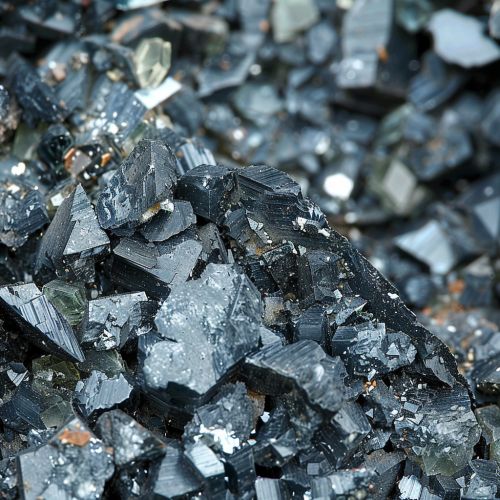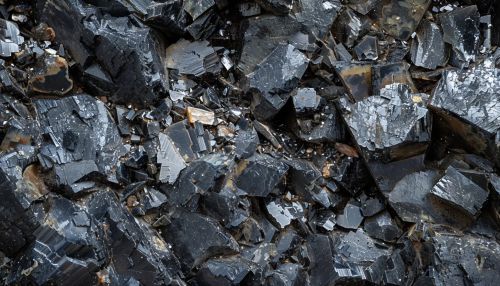Suevite
Introduction
Suevite is a type of rock that forms as a result of impact events, specifically meteorite impacts. It is a polymict breccia, meaning it consists of a variety of rock fragments and minerals that have been cemented together. Suevite is characterized by the presence of shocked minerals, glassy inclusions, and a matrix that often contains melted material. This rock type is significant in the study of planetary geology and impact cratering processes.
Formation and Characteristics
Suevite forms during the hypervelocity impact of a meteorite with a planetary surface. The intense pressure and heat generated during the impact cause the target rocks to undergo shock metamorphism. This process results in the fracturing, melting, and mixing of the rocks, creating a heterogeneous breccia. The key characteristics of suevite include:
- **Shocked Minerals**: Minerals within suevite often exhibit features indicative of shock metamorphism, such as planar deformation features (PDFs) in quartz and feldspar.
- **Glassy Inclusions**: The presence of glassy fragments, known as impact glass, is a hallmark of suevite. These fragments form from the rapid cooling of molten material.
- **Matrix Composition**: The matrix of suevite is typically fine-grained and may contain a mixture of melted and unmelted material. It often includes microcrystalline and amorphous phases.
- **Clast Diversity**: Suevite contains a variety of clasts, or rock fragments, which can range from millimeters to several meters in size. These clasts can be derived from different lithologies present at the impact site.


Distribution and Occurrence
Suevite is found at many known impact craters around the world. Some of the most well-studied occurrences include:
- **Ries Crater, Germany**: The Ries Crater is one of the best-preserved impact structures on Earth, and suevite from this site has been extensively studied. The suevite here contains a variety of shocked minerals and glassy inclusions.
- **Chicxulub Crater, Mexico**: The Chicxulub Crater, associated with the mass extinction event that wiped out the dinosaurs, also contains significant deposits of suevite. The suevite from this site provides valuable insights into the impact event and its aftermath.
- **Vredefort Crater, South Africa**: The Vredefort Crater is the largest confirmed impact structure on Earth, and suevite from this site has been used to study the processes of impact cratering and shock metamorphism.
Petrography and Mineralogy
The petrography and mineralogy of suevite are complex due to the diverse range of materials involved in its formation. Key components include:
- **Quartz**: Quartz grains in suevite often show shock features such as PDFs and diaplectic glass.
- **Feldspar**: Feldspar can be present as both shocked and unshocked grains. Shocked feldspar may exhibit features such as twinning and fracturing.
- **Impact Glass**: The glassy inclusions in suevite are formed from the rapid cooling of molten material. These inclusions can vary in composition depending on the target rocks.
- **Accessory Minerals**: Suevite may contain a variety of accessory minerals, including zircon, apatite, and magnetite. These minerals can provide information about the conditions of the impact event.
Geochemical Analysis
Geochemical analysis of suevite can reveal important information about the impact event and the target rocks. Techniques such as X-ray fluorescence (XRF) and inductively coupled plasma mass spectrometry (ICP-MS) are commonly used to analyze the elemental composition of suevite. Key findings from geochemical studies include:
- **Elemental Enrichment**: Suevite often shows enrichment in certain elements, such as siderophile elements (e.g., nickel, cobalt) that are associated with the meteorite.
- **Isotopic Signatures**: Isotopic analysis can provide insights into the age and origin of the impact event. For example, radiometric dating of zircon grains in suevite can be used to determine the age of the impact.
- **Volatile Content**: The volatile content of suevite, including water and carbon dioxide, can provide information about the conditions of the impact and the subsequent cooling and alteration processes.
Implications for Planetary Geology
The study of suevite has important implications for our understanding of planetary geology and impact cratering processes. Key areas of research include:
- **Impact Cratering Mechanics**: Suevite provides valuable evidence for the mechanics of impact cratering, including the processes of shock metamorphism, melting, and mixing of target rocks.
- **Planetary Surface Processes**: The presence of suevite on planetary surfaces, such as the Moon and Mars, can provide insights into the history of impact events and surface processes on these bodies.
- **Astrobiology**: The study of suevite can also have implications for astrobiology, as impact events can create habitats for microbial life and influence the conditions for the origin of life.
